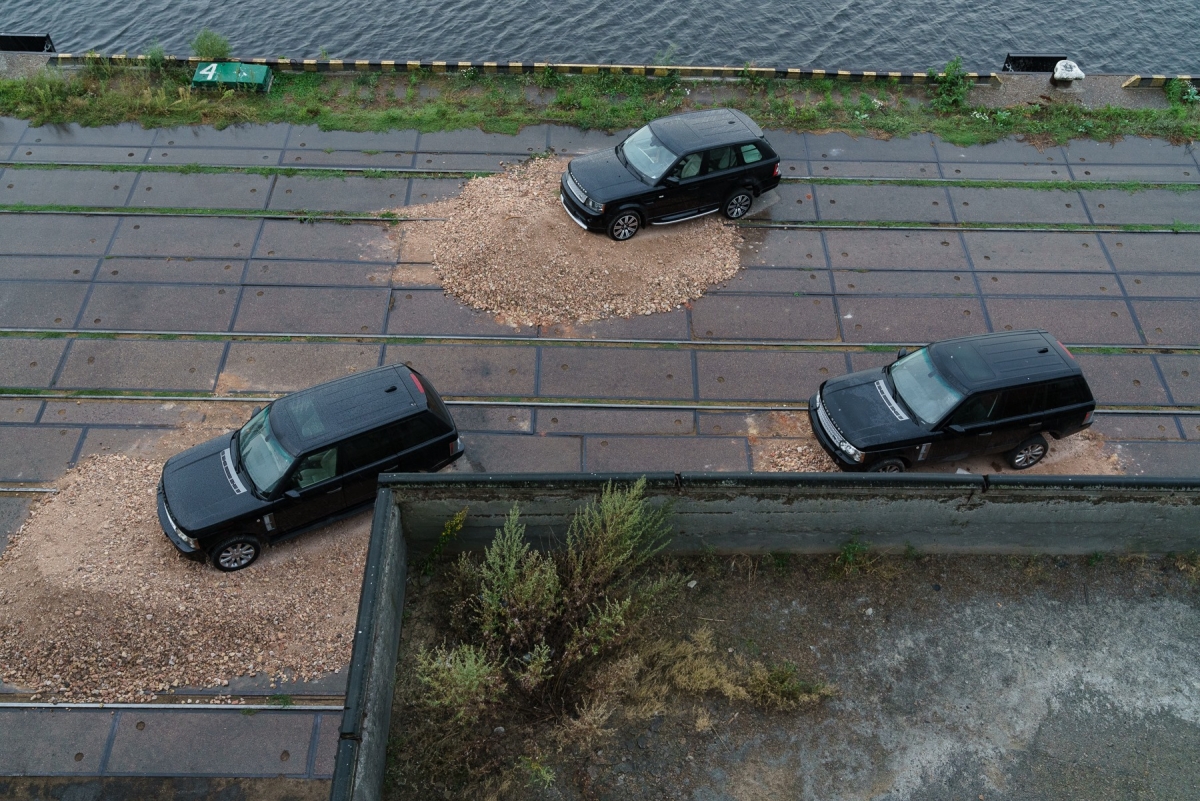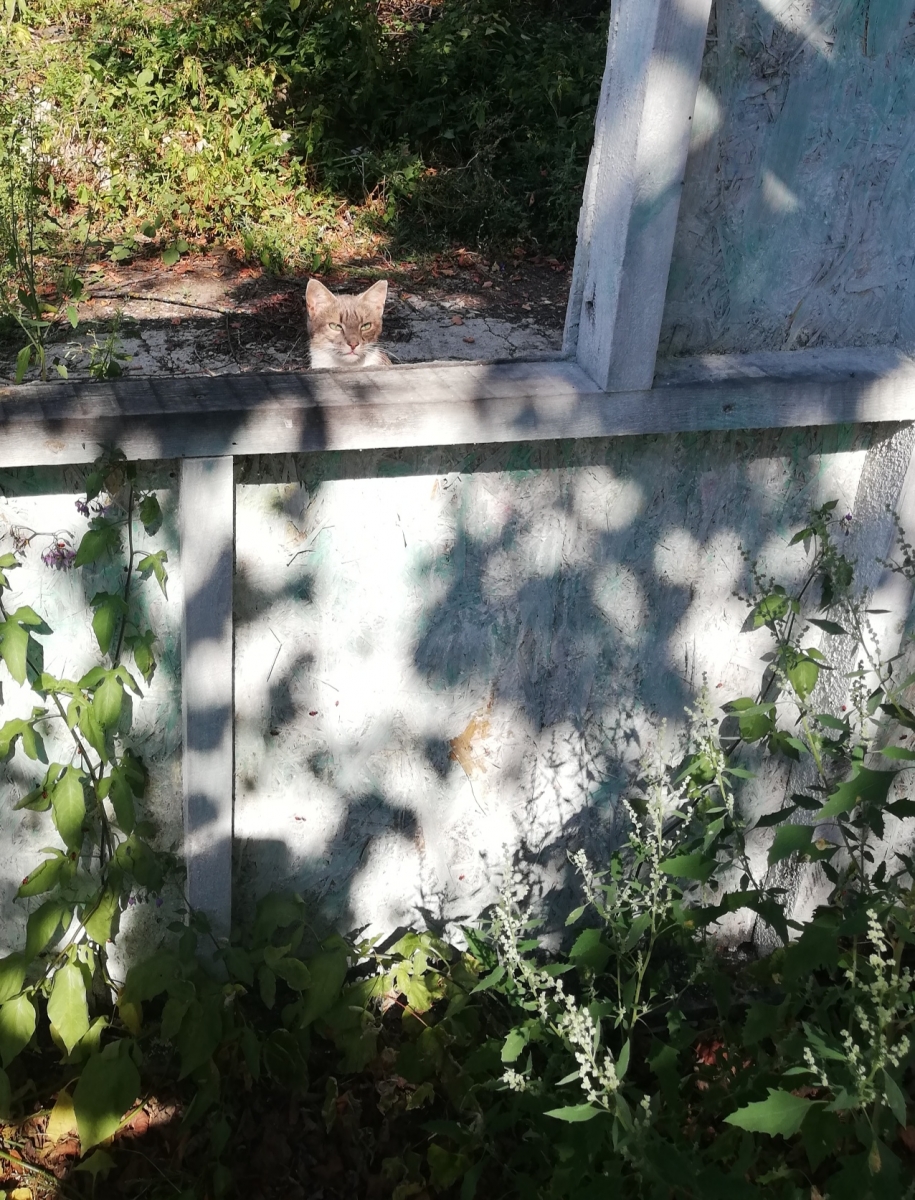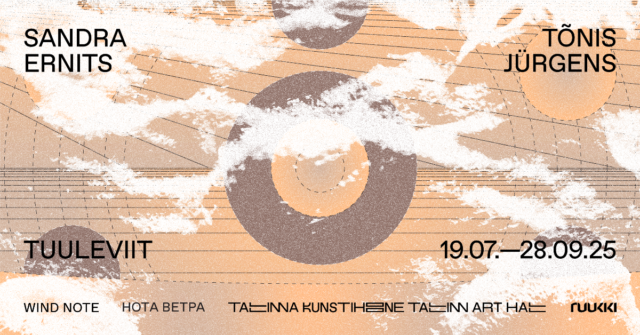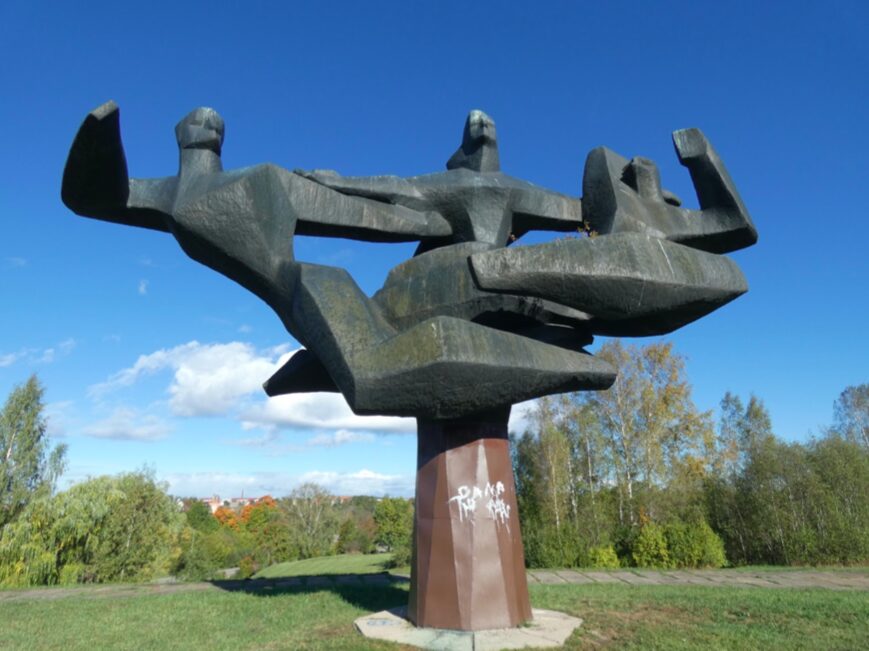Neighbouring the splendid Art Nouveau architecture, a mysterious zone exists on the river bank. There, it would be strange not to meet a ghost like something drifting out of a Tarkovsky movie: Andrejsala, as a metaphor, stands for failed Soviet dreams and capitalistic hopes, where stray cats now stroll, where plants sprout from ruins, and Riga’s Biennial is in bloom. Traveling through this eerie place, it is advisable not to drift off-course, but to keep looking for secrets in the chronological order marked out on the map as you never know what might be lurking in the outskirts.
And suddenly it all blossoms after Everything that Was Forever, Until It Was No More. Rebecca Lamarche-Vadel, curator of this year’s biennial, believes the end of the world has already happened, now we have to do something about it. Perhaps we should grow a new one, or at least try not to stay in the apocalypse for too long – the future is now open! So we should probably start knitting networks with those who moved in, with “uncertainty, poetry, spiders and silences, women and dreams…”[1] We should make movies, create myths and write books about it. Who doesn’t like to think about the end of the world especially if it doesn’t end badly for you?
But someone’s always left behind. Although, in any case receive flowers: even if all they can do is crawl on their petals on camera. The biennial is blooming with metaphors this year and to make it easier to communicate, a special glossary has been prepared containing words like: Endings, Nature, Love, Ruins, Healing, Magic, Cosmos, Underground, Care, Dreams, Dance, Imagination, Human, Wildness, Ghosts, Language, Metamorphosis, Voices, Fictions and Futures[2]. And yet, ecology’s been left between the lines, although it seems to still be that fragile blossom that keeps popping up throughout the biennial. Ecology’s not just a matter of replacing plastic straws with paper ones. It is not just a metaphor or a flamboyant approach that has little to do with our every day-to-day. The issue of ecology is always both ethical and political because it involves our relationship with other beings, Timothy Morton would say to the table, which would firmly agree. Likewise, metaphors are more like glasses through which we look at the world. Things that appear in the shade don’t change, but if we find some details a little too bothering, they can either be accentuated or obscured.
When talking about how viruses and other microscopic bodies act, we tend to use metaphors of war saying, they are attacking us, or we have to compete, we have to win against them. Of course, coronavirus is not quite the creature you’d want to hang around with too much, but at the biennial this eerie fellow is acknowledged as an important co-curator with its own ideas and solid opinions. The changed plans have been marked in orange and are easily noticeable throughout the RIBOCA2 accompanying booklet. Some original plans have gone missing, while others have changed shape or have shrunk to pocket-size.

Nina Beier, Total Loss, 2020. RIBOCA archive
Upon walking in, I am flamboyantly greeted by Ugo Rondinone’s rainbow-coloured Life Time[3], preparing my eyes for a variety of perspectives. Not only contemporary and older generation artists have been invited to contribute works to this journey, but also participants from other fields as well. Doctor of Pharmacy Vija Eniņa gives the biennial’s title a blossoming prospect by spreading new seeds over the grounds of Andrejsala. Though vital decisions are handed over to the earth’s fondness, such healing plants will only bloom if the seasons take care to nurture them. Simultaneously, the Institute of the Cosmos wonders are plants conscious and should we eat them?[4], delving into issues that come into view when considering living together with non-humans. Especially being close to our bodies, bioethical questions can start to make our hands shake as we lose it. And when panic sets in, we must remember to breathe.
However, oxygen isn’t always available to all. Despite being essential for all bodies to live, this invisible luxury circulates more easily in the lungs of the privileged. Those who still lack the space to breathe are perhaps represented in the part of the biennial where traces of queer life and history are presented. During the Soviet period, parks of Riga’s Old Town and the seaside of Jūrmala were free breathing oases that allured those from the Baltics being oppressed based on their sexuality to cruise there. In the work Riga Postcards, Estonian artist Jaanus Samma shares long-hidden stories about such vivid breathing practiced in sexual encounters that the queer Latvian clerk, Kaspars Aleksandrs Irbe (1906-1996), collected in his diaries for many years. Through elements of this work, Saama reveals to us a past in which the queer subculture of cruising remained almost invisible and unspoken. On the 22nd of August, in the front yard of the old house in Jūrmala where Kaspars Irbe used to live, a conversation moderated by curator and art theorist Kaspars Vanags took place with artist Jaanus Samma and historians Ineta Lipša and Uku Lember whereby curious stories were told and some intriguing pictures were shown. Queer ‘physical education’, which started with a meaningful wink of a thrilled eye, could be only practiced during the day or on lunch breaks – evenings were left for traditional family affairs.
Delving deeper into the body, artist and saxophonist Bendik Giske believes breath has an empathic power. Playing the saxophone, Giske drifts through a journey of emotional states that pierce through masculine stereotypes and fears of self-expression. Meanwhile, just next door a fragile mantis is climbing on colourfully dressed Faggots, Friends[5] in a film by artist Alex Baczynski-Jenkins.

Cat in the Anastasia Sosunova’s town. Photo by Greta Eimulytė
Traveling along the quay, I find myself standing in the middle of an abandoned paintball town, where intriguing objects emerge from a vague but strangely familiar reality in artist Anastasia Sosunova’s Habitaball. Wandering around, I feel like an alien allowing myself to enter a stranger’s house while the host is out. But I’m not the only curious being there – I meet several spiders settled in between the works and a nosy cat lurking through the window. Sosunova’s works, established in the ruins of entertaining war games, bring chilling echoes of neighbourhood conflicts happening at the moment. It stays in the back of my mind, certainly more reminiscent of a horror story than a reality we’d prefer to live in. My running thoughts get lost in one of the rooms where the hair of a table acts wavy.
Meanwhile, in the main building of the port of Andrejsala, a group of quite friendly-looking bodies sit quietly in artist Augustinas Serapinas’s artwork where snowmen have turned into Mudmen. The work reminds me of a sincere human attempt to get closer to what we call nature, to hook up and work with, believing it will all behave “as it should”. The previous winter passed without snow, so Serapinas’s idea has been to build a hundred snowmen on the streets of Riga turning it into a summer workshop and task for the imagination: how will we change our winter rituals if incrementally there will be less snow?
An optimistic answer is nowhere to be found. So in artist Eglė Budvytytė’s film Songs from the Compost: Mutating Bodies, Imploding Stars death is danced. Shot in the lichenous forests and sand dunes of Lithuania’s Curonian Spit and led by the dramatic lyric we have never been pure, we have never been clean, the movie turns into “a hypnotic exploration of the darker aspects of symbiotic life in the forest”. Into the category of darkness falls death and decay, which moves a group of teens in a choreography that is filled with post-human erotics. Wading in water, synchronously hugging each other and moss, various human bodies look for ways to imagine nonlinear time, making connections with other living and lifeless things, to merge. In the same space, in its cosmic choreography, artist Ieva Krish’s Polemic of Two Metrics[6] also spins. The installation is derived from the puzuris: a daily companion or a miniature of the universe of Lithuanian and Latvian ancestors able to repel evil spirits and store energies. On a simplistic level, it is cosmos in the kitchen. Split in half and accompanied by an ambiance, Krish’s version of puzuris is based on Serbian writer Milorad Pavic’s thoughts about the universe being created when time cut eternity into two and thus made two eternities out of one: the present and the future.[7]
The installation called Currents, by artists Lina Lapelytė and Mantas Petraitis, brings me back to the port of Andrejsala where raftsmen used to carry wood in the Middle Ages. Over time, they learned to adapt to the choreography of the river, or should we say, they started cooperating with it, dancing with the water. But something was, of course, left behind. Responding to issues of capitalism and ecology, and traditional raftsmen songs, this temporary pine island floats with a new poetic soundtrack highlighting where the human collaboration with natural elements helped them capitalise off of one another[8].
So we’re masterful sneaks, able to escape from all the tricky questions we set for ourselves, trying to suddenly shelter every non-human we meet on our way. Without Tarkovsky’s ghosts, spiders and resident plants, stray cats also appear to have found a cosy place in Andrejsala during the abandonment (it would seem, having even met a local cat promenading among the paintball buildings). Independent cats seen in residential areas are not such a rare occurrence: I remember once having a neighbour who was convinced that a cat not sleeping on a heated floor is a cat at a total loss. So a bowl of milk was always left outside the door with small pieces of food sprinkled here and there. She was sincerely happy just to take care, though this seemed to completely erase the detail that milk isn’t actually so suitable for cats as a species. In artist Nina Beier’s work entitled Total Loss, she offers a much more luxurious shelter with marble lions soaked in vegan milk (suitable even for lactose intolerant cats!). Total Loss, accompanied by a performance of pregnant women in Range Rovers, presents as a metaphor for the capitalist activities tiring the earth, but it seems to have contributed to the milking of nature as well. Over the past decade, the overproduction of soybean has become synonymous with deforestation and although the soy drink that has become a luxurious item is seen as saving cattle species from suffering in the dairy industry by destroying another. Anyway, we are the only species able to brag about it having almost succeeded in destroying the earth. Moreover, we have the luxury of not only considering the world-ending options, but also accomplishing them in an artistic manner.
For example, dancing: in your bedroom even, or in the kitchen with a cup of coffee. Latvian goddess Veļu Māte organises deathly parties right in the cemetery, attracting crowds of ghosts (her name literally means the mother of bedding and underwear). The star of the underworld and of the dead was to appear between luxurious fabrics and lace curtains in Andrejsala as well. However, the port was only reached by the Yawn of a Sleepy Heart, a stained-glass portrait of Veļu Māte by artist Dominika Olszowy, in which a ghost appears to be running out of a coffee-smelling nose. Sometimes actors sit next to the ghost and weep.
Yawning acts as a window through which wind blows restless souls into our private rooms. Only by dancing with them can we smell the world ending.
I wonder what blossoms we’ll leave for our souls.
Photo documentation from RIBOCA2 here.

Dominika Olszowy, Yawn of a Sleepy Heart, 2020. RIBOCA archive

Lina Lapelytė and Mantas Petraitis, Currents, 2020. Photo: Ugnius Gelguda

Jaanus Samma, ‘Riga Postcards’, 2020. Photo: Ugnius Gelguda
[1] https://riboca.digital/en/page/curatorial-concept-by-rebecca-lamarche-vadel
[2] https://www.rigabiennial.com/en/riboca-2/programme#tandc
[3] Ugo Rondinone, Life time, 2019, https://riboca.digital/en/artworks/02
[4] The Institute of the Cosmos, https://riboca.digital/en/artworks/38
[5] Alex Baczynski-Jenkins, Faggots, Friends, 2019-continued. https://riboca.digital/en/artworks/28
[6] IevaKrish, Polemic of Two Metrics <> Variation of Polymetrics, https://riboca.digital/en/artworks/23





























